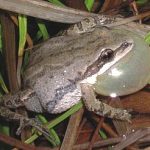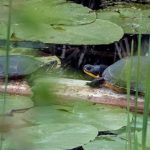Well that was fast: Thanks to an overwhelming response, this newly-launched program is full for 2018. Check back for opportunities in 2019!
This program takes volunteers to Conservancy properties in teams of two to monitor Reptiles & Amphibians.
If you want to spend more time on Conservancy properties, make a meaningful contribution to the protection of nature, and improve your naturalist skills all at the same time, this is the program for you.
We have now recruited volunteers and have set training dates for the winter and spring of 2018. No previous experience is necessary to participate in this program.
There are three programs to choose from:
Frog Call Monitoring Reptile Monitoring Salamander Monitoring
Reptiles and Amphibians are particularly vulnerable to decline in Canada and the world, and are considered indicator species for climate change, pollution, and habitat loss. By monitoring Reptiles and Amphibians, you will be helping the Conservancy to steward our properties. More specifically, you will contribute to our understanding of:
- Changes to the Reptile and Amphibian abundance and species composition in our region
- The quality and condition of our wetlands
- The presence or absence of listed Species at Risk
The information volunteers collect will also contributed to the Reptile and Amphibian Atlas of Ontario.
Choose from the following programs or participate in all three:

The Western Chorus Frog is listed as Threatened in Ontario
1. Frog Call Program. There are approximately 10 frog and toad species in our region, and volunteers will be trained to identify their calls. Listening devices with headphones can also be used to verify calls .
Commitment: Volunteer teams of two will head out 1/2 hour after sunset to a Conservancy wetland. Three trips of fifteen minutes each spring, at different temperature thresholds, are all that’s required.
Skills Needed: Take our Frog Call training course. Using the Bird Studies Canada “Marsh Monitoring Program” protocols, you will learn how to identify 10 frog and toad calls individually and as part of larger choruses. There are two dates to choose from: Sunday March 25th 2018 from 1:30 to 3:30 pm – or- Wednesday April 4th 2018 from 1:30 to 3:30 pm. Both courses will be offered at Grant’s Woods.
For more information, email or phone dorthea@couchconservancy.ca (705) 326-1620

Spotted Salamander photo: Dave Hawke
2. Salamander Monitoring Program. Salamanders are one of the most elusive amphibians to study, but are very important to the ecosystem. For example, they prey on mosquitoes and ticks, helping to keep insect populations in balance. This fall we put out boards on four Conservancy properties that we hope salamanders will choose to live under, and this monitoring program asks volunteers to check in on the boards and record what they see.
Commitment: Volunteer teams of two will be assigned a Conservancy property which has had 20 boards placed in good salamander habitat. Three trips of approximately 2 hours in the spring will be required (roughly late April, late May, and late June).
Skills Needed: Take the Reptile and Amphibian i.d. Training course. You will learn to identify the reptiles (turtles, snakes, lizard) and amphibians (salamanders and frogs) of our region by sight. Two dates to choose from: Sunday February 25th 1:30 to 3:30 pm – or – Wednesday March 7th 1:30 to 3:30 pm (location TBA depending on number of registrants).
For more information contact dorthea@couchconservancy.ca (705) 326-1620
Note: A rudimentary understanding of gps units and/or the Avenza mapping app is also necessary on most properties to be able to find the salamander boards. Click here to visit our Volunteer Training Opportunities page to see training dates and sign-up info for Avenza and GPS.

Painted & Blandings Turtle at Wye Fen. Photo: Dave Hawke
3. Reptile Monitoring Program: By following a pre-planned route, volunteers will stealthily sneak up on Reptiles: turtles, snakes, and the five-lined skink. The five-lined skink is Ontario’s only lizard.
Commitment: Volunteer teams of two will take the Reptile and Amphibian Identification Training course and will be assigned a property to monitor. Reptile monitoring visits will take place once per month throughout the spring and summer.
Skills Needed: Take the Reptile and Amphibian i.d. Training course. You will learn to identify the reptiles (turtles, snakes, lizard) and amphibians (salamanders and frogs) of our region by sight. Two dates to choose from: Sunday February 25th 1:30 to 3:30 pm – or – Wednesday March 7th 1:30 to 3:30 pm (location TBA depending on number of registrants).
For more information contact dorthea@couchconservancy.ca (705) 326-1620
Understanding how to use the Avenza Maps app or a gps unit is beneficial but not essential for Reptile monitoring. Click here to visit our Volunteer Training Opportunities page to see training dates and sign-up info for Avenza and GPS.
In addition to Avenza and GPS, there are several more courses offered to supplement your naturalist skills while out in the field. Other courses include Species at Risk and Invasive Species. Visit our “Volunteer Training Opportunities” page to learn more. To learn about other Volunteer Jobs with the Couchiching Conservancy click here.
Thanks to the Youssef-Warren Foundation for funding our dream of a Citizen Science Reptile and Amphibian Monitoring Program.
